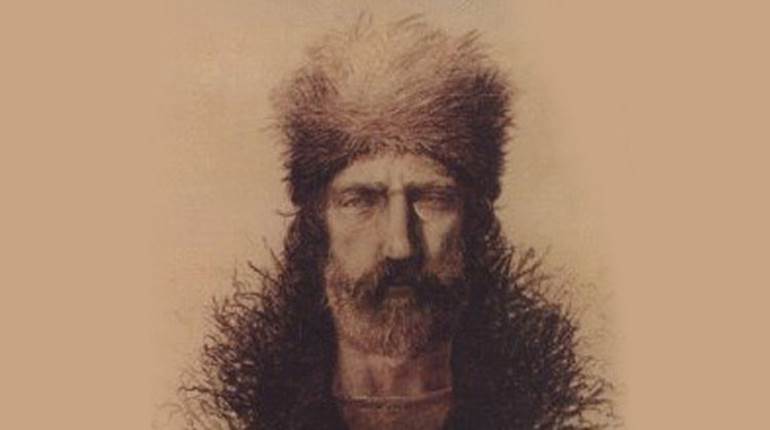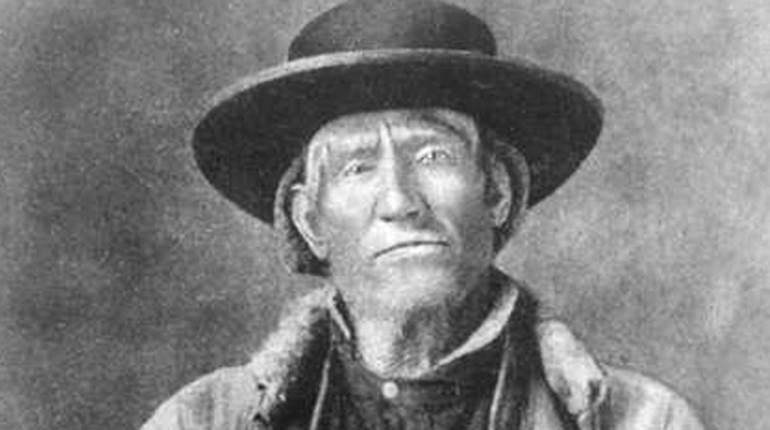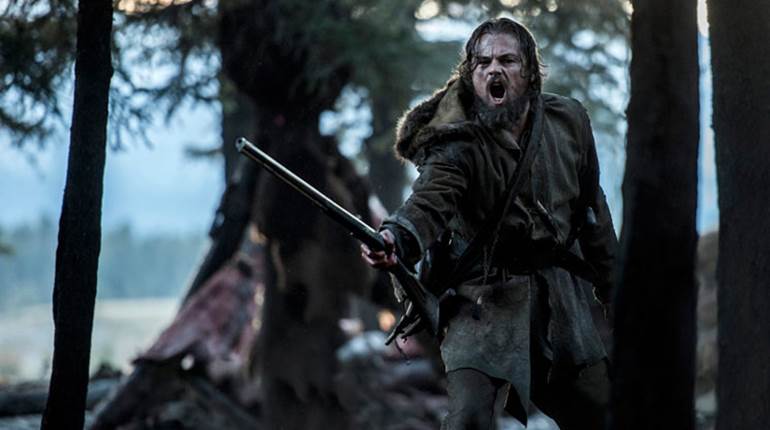
Revenant: noun rev·e·nant \ˈre-və-ˌnäⁿ, -nənt\ one that returns after death or a long absence. (Merriam–Webster Dictionary Online)
A revenant is a visible ghost or animated corpse that was believed to return from the grave to terrorize the living. (Wikipedia entry sourced to England Under the Norman and Angevin Kings, see Chapter 11, Section 6 "Death and the Dead".) 
On Jan. 8, 2016 “The Revenant,” starring Leonardo DiCaprio, hit theaters nationwide, and early indications are that the film will be one of the first blockbusters of the year. With star power like DiCaprio in the role of legendary fur trapper and mountain man Hugh Glass, and Thomas Hardy as John Fitzgerald in a film directed by the Academy Award winning Alejandro Iñárritu, how could it fail?
Well, actually, it could fail on many levels and, sadly, in my opinion, it does. It’s a case of good news vs. bad news and which do you want first?
The good news is this is an amazing film. It is bound to garner serious Oscar nods for Leonardo DiCaprio, as well as Emmanuel Lubezki, the director of photography. DiCaprio’s portrayal of a man seriously mauled by a grizzly bear and left for dead only to crawl back to civilization after traversing over 300 miles of frozen wilderness is nothing short of spellbinding. Lubezki’s use of ambient light exclusively gives this film an amazing feeling, texture and totally immerses the viewer in the harsh dreariness of a long winter in the upper northwest. Immediately after viewing the film I wanted to book travel to Sarasota on the next available flight, never to look back. (They don’t have Grizzly bears in western Florida, do they?)
On the other hand…
When American Rifleman Editor-in-Chief Mark Keefe saw the previews for the film, he and NRA Publications Editorial Director John Zent immediately thought to ask my opinion on the one question that many of our readers would ask: Did they get the guns right?
The short answer is, yes, they did. They actually went to a bit of trouble to get them correct, and that effort shows in the finished product. Not everything is perfect, nor could you really expect it to be, but for the most part it is a much better effort than some past offering from Hollywood in which U.S. Model 1873 “Trapdoor” Springfields abound with bronze “flint hammers and frizzens” cosmetically added to give the center-fire rifles the look of muzzleloaders.

The back story on the guns is this: Author Michael Punke wrote a novel in 2002 called The Revenant, and the screen rights were sold before it was actually published. Once the film was green lit, production assistants—PAs for short—began a four-year process of getting everything organized to actually begin filming. Punke writes in the novel that Hugh Glass had a beautiful long rifle: “The octagonal barrel was inscribed at the base with the name of its maker, “Jacob Anstadt” and the place of its manufacture, Kutztown, Penn.”
A PA, wishing to know exactly what an Anstadt rifle looked like, searched for it on the web. A Joseph (not Jacob) Angstadt (not Anstadt) popped up in the search results on the website of Ron Luckenbill, a 72-year-old retired policeman and NRA Life Member who started to make longrifles as a hobby back in 1998. Luckenbill had an Angstadt rifle for sale at one time, but it had recently sold. “Why do you ask?” he inquired. The PA spilled his guts about what it was he was looking for. “Is it possible to find two original Joseph Angstadt rifles for use in this movie, ASAP?”
Luckily for all concerned, Ron had a rifle styled after Bucks County maker John Shuler on hand and ready for immediate sale. He knocked off a carbon copy of it in 30 days and the production company had its two “hero” guns ready for filming.
Except there was just one small detail remaining. In the novel Punke writes: “The barrel was short, only thirty-six inches.” He then goes on to explain that the Hugh Glass of his novel wanted a short rifle, saying that it was lighter and easier to maneuver while on horseback while still being very accurate, short barrel or not. “With a full charge of 200 grains of black powder, the Anstadt could throw a .53 caliber ball nearly 200 yards.” Sadly it is here that we find Punke’s tell; he really has no familiarity with firearms of the period. (“A whole 200 yards? That far, eh?” remarked Mark Keefe after I read him the quote.) The PA asked Ron if he could cut 10” off the barrel of the Shuler rifle and make the second one the same length. Ron said he couldn’t do it. “It would be too much like cutting off the arm of one of my children. I just couldn’t do it.” He went on to say, “What they did with the rifles after they were paid for and shipped was no longer any of my business.”

Despite the practical problems of trying to adapt a technically flawed novel to films, the theater-goers will also encounter a few other troubling missteps along the way. This film is based on a novel. A work of fiction. The movie is based on the novel. The disclaimer “Inspired by True Events” is just that, a disclaimer. In 1823 there was a mountain man named Hugh Glass. He got mauled by a bear. It was cold. He lived. End of historical similarities between the film and what really happened.
Why does Hollywood keep doing this to us? It’s like being in a really abusive relationship. The geek historian in me is salivating at the thought of a great film that hits all the high notes of historical accuracy. Every time I think someone has clued in and decided to go to the extra effort to make "it right," as evidenced by the remarkable “Band of Brothers” (2001), I get sucker punched in the guts with something as off target as "The Revenant."
Hollywood delivered a rash of mountain man movies to the public more than 40 years ago. “The Man in the Wilderness” (1971), “Jeremiah Johnson” (1972), “The Life and Times of Grizzly Adams” (1974) and our own Charlton Heston in “The Mountain Men” (1980). Some of these films have taken on cult status while others are now hardly remembered. Director Alejandro Iñárritu hopes that his film will stand above all others for its attention to detail, realism and sheer beauty, and much like the tale of Hugh Glass himself, that this film will be the one spoken of with pride and reverence around the campfires of the rendezvous and living history encampments for generations to come.
And to his credit, Iñáarritu did go to some effort to at least get the feel and texture of the era and lifestyle of the mountain man accurate. Clay Landry, a living historian of the mountain man/fur trade era for the past 45 years, was hired as a technical advisor to help set up a period correct trapping outpost and put the actors through a boot camp that exposed them to the ways of the wilderness frontiersmen of the 1820s. He related that DiCaprio and Hardy knew their way around firearms and the basics of safe handling, but they had no experience with guns from the flintlock period. Landry educated them to the point that they really look like they know what they are doing when you see them handling, loading and firing their guns on film.

One noticeable misstep are the close-up scenes where the trappers of the expedition are fending off a massed attack of Arikaras (nick-named “Rees” by the trappers). As they aim for targets it is quite evident that most of the rifles are at half-cock and would be incapable of firing a shot if the trigger was pulled. DiCaprio also manages to reload a pistol while astride a horse at full gallop in what would seem to be record timing.
To the geek in me, these are minor annoyances, and they don’t cripple my interest in the film to the point where I’d leave the theater in disgust. The biggest problem I had was with the actual story line and the wide berth it gives to anything resembling the actual story.
The story of Hugh Glass is a story of an American Odysseus, someone of Homeric proportions who, despite what God, man, mother nature and the elements throw at him, manages to survive. He survives epically. He has a goal, motivation, a reason for living. He is on a quest and that quest is not a blushing, native bride nor a son in swaddling clothes. No, to the real Hugh Glass and not the one now delivered to us via 70 mm Panavision lenses, the object of his quest is his rifle. The one thing on earth that Glass knew better than his own heart, body, mind and soul, was his rifle.
Those quick to defend the novel and the movie as works of fiction, the employing of literary license etc., etc., will add that there isn’t actually a whole lot we do know for certain about any of the Hugh Glass story except for him being mauled and living to tell the tale.
There is enough of the real Hugh Glass out there to make a compelling story however. Hugh Glass was, by some scant accounts, born near Philadelphia sometime around 1780. When he was approximately 15 years of age he was living in western Pennsylvania and apprenticed to Henry Wolf of Pittsburgh as a gunmaker. Wolf was, evidently, not a pleasant person to work for as evidenced by the numerous ads he took out in the local paper over the years offering a reward for run-away apprentices. The cause for the young Glass to take heel to toe and leave his mentor/employer in 1795 is now lost to history. Evidently, Wolf was not too grieved by the loss as he posted a reward for the return of Glass but only for the paltry sum of 6 pence. No doubt that during his brief time with Henry Wolf, Glass would have picked up an appreciation for finely crafted rifles as Wolf’s are considered quite rare and well executed by today’s collectors.

There isn’t really a whole lot we know about Glass after he runs off from Messer. Wolf. Some say he was a merchant seaman, captured and forced to serve in the pirate fleet of Jean Lafitte. Deserting the pirates and barely escaping with his life he ran inland and was soon adopted by a tribe of local Pawnee. He lived among them for more than five years, learned their ways and language, and he became quite honored by the tribe, which was devastated when he left for St. Louis to begin a new life as a trapper and mountain man. He joins up with a fur company expedition that was trapping beaver in the northwest corner of what we now know as South Dakota. In late August 1823, he is set upon by a grizzly bear that leaves his body lacerated and shattered. This much we know because of a surviving letter written by one of Glass’s trapping companions. Fellow mountain man Daniel T. Potts writes just a few weeks after the events concluded (July 7, 1824) “One man who also tore nearly all to peases by a White Bear and was left by the way without any gun who afterwards recover’d.”
A year later James Hall writes in a Philadelphia magazine a more detailed account that even names Hugh Glass as the man "... tore nearly all to peases ... ."
The celebrated General Philip St. George Cooke, while a junior lieutenant on the frontier, pens a very detailed missive about Glass in 1830. After that, stories abound about Glass for the next 100 years. Most notable among them is John Neihardt's 1915 effort entitled The Song of Hugh Glass. Neihardt's verse is 120 pages long and attempts to replicate Homer's saga of Odysseus by making Glass the American counterpart to that ancient Greek hero.
In 1954, Frederick Manfred publishes his novel Lord Grizzly and it rapidly becomes a national bestseller. During the era when Davy Crockett and Daniel Boone were television sensations, Lord Grizzly captured the imagination of a new generation of Americans.
Finally, in 1963, John Myers Myers tries valiantly to dig deep into the truth of Hugh Glass with his epic Pirate, Pawnee, and Mountain Man: The Saga of Hugh Glass. Myers examines every written account of Hugh Glass's life and sifts fact from fiction to come up with a compelling tale that staggers the imagination. By comparing and contrasting the varying accounts, Myers paints the picture of a man possessed. A man who did not know the meaning of the word fail. A man who, although physically shattered, speechless, racked with lacerations and infection, manages to crawl over a period of four months and 300 miles through unfriendly frozen wilderness back to safety with one quest on his mind. He wanted his rifle back.

There was no Pawnee wife or children to motivate him, no real cause for revenge, either, as he understood that Jim Bridger and John Fitzgerald honestly thought he was as good as dead. He may have done the same thing if their roles were reversed. The one constant in every telling of the tale until “The Revenant” opened was Hugh Glass wanted his gun back. That rifle was special not only to him but to every man that knew Hugh. Many stated that his rifle was of the finest Pennsylvania manufacture. Most rifles in that time period cost $40 when a good horse would cost $10 to $20. The value in cash money only, would today be the equivalent of two brand new automobiles. To Glass, he placed more value on his rifle than we would even consider placing on a new vehicle today. It was his life’s blood, it was his last remaining tie to his former home in Pennsylvania. It was worth doing everything he could manage to do, this side of dying, to get it back.
James Hall is the first to recount this as Glass's motivation. In his 1825 article he writes that after a journey of nearly 10 months Glass arrived at Fort Atkinson (near Council Bluffs) “... where he found his old traitorous acquaintance [Fitzgerald] in the garb of a private soldier. This shielded the delinquent from chastisement. The commanding officer at the post ordered his rifle to be restored.” It was about the rifle. It was always about the rifle. Every single 19th and 20th century retelling of the Glass saga cites the recovery of his rifle as his prime motivation.
Glass lived another 10 years, trapping and trading from St. Louis, to Taos, to Santa Fe, and in 1833 he found himself back where his journey had begun in 1823, along the banks of the Grand River in Northwest South Dakota. He was back in the land of the Arikaras. This time his luck failed to hold out for him. He and two other trappers were set upon by thirty natives while they attempted to cross a frozen river. Glass and his trapping companions were all killed.
But the story of Glass’s gun does not end with Glass. A short while later the Arikaras responsible for Glass’s death appeared at the camp of other trappers and feigned to be friendly Mandans. Their deceit was revealed when one of the men, Johnson Gardner, recognized Glass's rifle. It had to be a unique beauty, as Fitzgerald had clung to it for 10 months while he thought Glass had been turned into worm food. Gardner, too, saw the rifle for what it was, a rare and unique specimen of Pennsylvania craftsmanship. Once he realized the faux Mandans could only have killed Glass to posses it, he set upon them with a vengeance, killing them all.
So in the end, it was Glass’s rifle that bought him 10 years of extra life, and it also avenged him after it had ceased to be of earthly use to him.
Screen writer Mark L. Smith, who shares the credit for the screenplay with Alejandro Iñárritu, explained in an online interview how the effort to reclaim his rifle was dropped as Glass's motivation for survival:
“In my earlier drafts before Alejandro came on, my father-son stuff was different. My story was that the son had died previous to the journey, that he had been sick while he was young. You open with these scenes of Glass and son, carving a star in a hunting rifle—the stock of a hunting rifle. While they’re carving the star, the son is coughing and you know he’s dying. The son pricks his finger and blood falls into the star on the rifle, and then you flash forward and we’re right where we are with the attack. Glass is still holding the rifle, but it’s very worn and you can still see the star on the stock of the rifle.
"When Fitzgerald and Jim Bridger leave him, in my earlier drafts, Fitzgerald took the rifle. All Glass wanted to do was hold his rifle, so he’s gripping his rifle, because it means so much to him. Glass’ journey was less about revenge, more about getting his rifle back—which is almost like his son. It was almost a kidnapping story at that point. I didn’t like the revenge thing, so I didn’t go that route. Then Alejandro came in and added the son, because he thought it could be really powerful, and the idea because of he’s half-Native American the racism angle could come in and you could show the cultures and how they blended together.” (Interview: “The Revenant” Screenwriter Mark L. Smith Explores Love and Fear. Posted on Tuesday, Jan. 5, 2016 by Jack Giroux slashfilm.com)
So now the story of Hugh Glass has been told once more. The liberties taken with the real history are almost unforgivable but not unexpected. At least “Man in the Wilderness”(1971) had the decency to call Richard Harris’ character Zachary Bass instead of Hugh Glass, saving the memory of the hero from further indignation as the writers and director played fast and loose with the facts. 
“The Revenant” is an amazing film otherwise. It is visually stunning. DiCaprio and Hardy turn in Oscar-worthy performances. Alejandro Iñárritu will undoubtedly earn at least a nomination for Directing, but for what he did with the story line and Mark L. Smith’s original screenplay, he should be flogged publically by the History Police.
“The Revenant” (2015) - Rated R. 2:36 minutes. A New Regency/20th Century Fox Film. In theaters now.
For further information:
The man who made the primary rifle used by Leonardo DiCaprio and Thomas Hardy in the film, Ron Luckenbill, has a great website, Recreating History, that highlights his fine workmanship and tells more about the rifles of The Revenant.
Clay Landry is an advisor to two museums whose concentration is the era of the Fur Trade. He was a technical advisor on the film and has written extensively on the subject. He gave the film the period authentic look that makes it the best portrayal of the era ever presented on film. He is the author of many articles on the real Hugh Glass. You can find out about Hugh Glass from The Museum of the Mountain Man website.
The author recommends that all those interested in Hugh Glass begin by reading The Saga of Hugh Glass: Pirate, Pawnee, and Mountain Man by John Myers Myers (1963).
















![Auto[47]](/media/121jogez/auto-47.jpg?anchor=center&mode=crop&width=770&height=430&rnd=134090788010670000&quality=60)




















